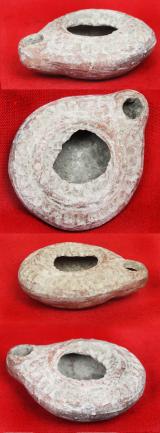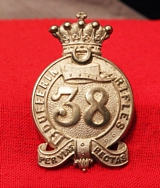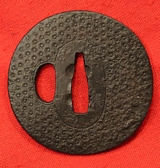A Finest Leather Field Service, .455 Revolver Holster, For WW1 Officers
Excellent condition, WW1 service officer use, for the Webley.455 MK VI revolver. It has a full flap cover with retaining strap and brass stud fastener
The Webley Revolver (also known as the Webley Top-Break Revolver or Webley Self-Extracting Revolver) was, in various designations, a standard issue service revolver for the armed forces of the United Kingdom, and countries of the British Empire and the Commonwealth of Nations, from 1887 to 1970.
The Webley is a top-break revolver and breaking the revolver operates the extractor, which removes cartridges from the cylinder. The Webley Mk I service revolver was adopted in 1887 and the Mk IV rose to prominence during the Boer War of 1899–1902. The Mk VI was introduced in 1915, during wartime, and is the best-known model.
Firing large .455 Webley cartridges, Webley service revolvers are among the most powerful top-break revolvers produced.
The Webley RIC (Royal Irish Constabulary) model was Webley's first double-action revolver, and adopted by the RIC in 1868, hence the name. It was a solid frame, gate-loaded revolver, chambered in .442 Webley. General George Armstrong Custer was known to have owned a pair, which he is believed to have used at the Battle of the Little Bighorn in 1876.
The Royal Canadian Mounted Police and Shanghai Municipal Police received Webley Mk VI revolvers during the interwar period. read more
165.00 GBP
Ancient Imperial Roman Discus Form Oil Lamp with Embossed Design Circa 100 AD
Lamps were used throughout antiquity for the principal purpose of lighting in domestic, civic and also religious contexts (funerary or votive) where permanent light was required. The origin of the lamp is not known for certain, but it had become commonplace in Greece by the 4th century BCE, where its use replaced that of the torch known from earlier times. Since the large scale production of olive oil which (amongst other things) was used as lamp fuel and constituted part of a major industry in Ancient Greece it is not surprising that the mass-production of lamps occurred as they were in constant demand. This demand continued well into the Roman period and the subsequent CE era. As the industry continued to grow, so did the varied styles of lamps, that illustrated incredible diversity in their shapes, decorations and materials. Shapes ranged from simple single nozzled ones to others that had 12 or more spouts. Others demonstrated zoomorphic (animal) or anthropomorphic (human) forms, while others had varied decorations confined to the top of the lamp with vegetable or abstract motifs, but also figural scenes (mythological, legendary, gladiatorial, domestic life, erotica etc). Further, while terracotta was the most common material used for the production of these devices, they were also made in stone or metal such as gold or silver, but they were most commonly produced in bronze. read more
125.00 GBP
A Scarce Original WW2 British '37 Pattern Commando Officer's 9mm Browning Hi-power Holster, Ammunition Pouch & Waistbelt 1942/3 in Excellent Plus Condition
This 3 commando holster set was acquired with a German Luftwaffe officers PPK holster but sold seperately. After WW2 the officer kept his Browning and the Walther PPK as souvenirs, but surrendered his Browning and the Walther to the police in the 1960's. We acquired both holsters from his grandson
The 9mm automatic holster was easily identifiable by its level top edge almost all revolver holsters being angled upwards. With top hooks to connect underneath an ammunition pouch as an option. The neat ammunition pouch could accommodate two 12 round packets, a fabric strip went over the brace adaptor and a fabric loop fitted at the bottom accepted the top hook of a holster. dated 42/43.
No. 3 Commando was a battalion-sized Commando unit raised by the British Army during the Second World War. Formed in July 1940 from volunteers for special service, it was the first such unit to carry the title of "Commando". Shortly afterwards the unit was involved in a largely unsuccessful raid upon the German-occupied Channel Island of Guernsey.
In 1941 they were involved in successful raids on the Lofoten Islands and Vaagso, in Norway, before taking part in the costly Dieppe raid in August 1942, where the unit was tasked with knocking out a German coastal artillery battery on the eastern flank of the main landings, although due to a chance encounter in the Channel with a German convoy, a large majority of the unit failed to make it ashore.
In early 1943, the unit was sent to Gibraltar before moving to North Africa in April from where they were involved in the Allied invasion of Sicily and operations in Italy prior to being withdrawn to Britain to prepare for Operation Overlord. On D-Day they went ashore on 6 June 1944 as part of the 1st Special Service Brigade tasked with linking up with the 6th Airborne Division on the eastern flank of Sword before being withdrawn. Later they took part in the Allied counterattack during the Ardennes Offensive in early 1945 before taking part in the advance into Germany as part of Operation Plunder.
Following the end of the war, No. 3 Commando carried out occupation duties in Germany before it was disbanded on 4 January 1946. read more
190.00 GBP
Victorian Silver Very Scarce Canadian Officer's Badge of the 38th Dunfferin Rifles
In superb crisp order. A mighty rare badge. Originated 28 September 1866 in Brantford, Ontario as the 38th "Brant Battalion of Infantry"
Redesignated 30 November 1866 as the 38th "Brant" Battalion of Infantry
Redesignated 24 March 1871 as the 38th "Brant" Battalion of Rifles
Redesignated 3 July 1874 as the 38th "Brant" Battalion or "Dufferin Rifles"
Redesignated 28 September 1883 as the 38th Battalion "Dufferin Rifles of Canada"
Redesignated 8 May 1900 as the 38th Regiment "Dufferin Rifles of Canada"
Redesignated 1 May 1920 as The Dufferin Rifles of Canada
Amalgamated 15 December 1936 with The Haldimand Rifles and C Company of the 3rd Machine Gun Battalion, CMGC
The 125th Battalion (1st Overseas Battalion of 38th Regiment Dufferin Rifles), CEF was a unit in the Canadian Expeditionary Force during the First World War. Based in Brantford, Ontario, the unit began recruiting in late 1915 throughout Brant County. 43mm x 70mm read more
265.00 GBP
A 13th Century Iron Head, Crusader Knight's Battle Mace, 800 Years Old, Mounted Upon A Later Museum's Display Haft
Pineapple shaped lobes on circular head with large mounting hole through which the haft slots. it was fitted to a plain wood haft for a museum display, as its original rotted away centuries ago as usual, in order to show how it looked and was used 800 years ago.
This type of mace head were also used as a Flail Mace, by filling out the hollow iron head with lead and a chain mounted hook placed within it, a chain would then be added to the end of a similar but shorter wooden haft. This subsequent mace head weapon could thus then became a flail, often called a scorpion at the time.
This very fine and rare iron mace head has flattened pyramidal protuberances, and is possibly English. Made for a mounted Knight to use as an armour and helmet crusher in hand to hand mortal combat upon his war horse, or then for use dismounted.
It would have been used for several hundred years, up to the 15th to 16th century.
Used as a flail it had the sobriquet of a Scorpion in England or France, or sometimes a Battle-Whip. It was also wryly known as a 'Holy Water Sprinkler'.
King John The Ist of Bohemia used exactly such a weapon, as he was blind, and the act of 'Flailing the Mace' meant lack of site was no huge disadvantage in close combat. Although blind he was a valiant and the bravest of the Warrior Kings, who perished at the Battle of Crecy against the English in 1346. On the day he was slain he instructed his Knights both friends and companions to lead him to the very centre of battle, so he may strike at least one blow against his enemies. His Knights tied their horses to his, so the King would not be separated from them in the press, and they rode together into the thick of battle, where King John managed to strike not one but at least four noble blows. The following day of the battle, the horses and the fallen knights were found all about the body of their most noble King, all still tied to his steed. In fact so noble were his actions regarded, it is said his banner of three erect and standing feathers became the symbol of the then Prince of Wales, Edward, the Black Prince, and as such, is still used by the current Prince of Wales today.
During the Middle Ages metal armour such as mail protected against the blows of edged weapons. Solid metal maces and war hammers proved able to inflict damage on well armoured knights, as the force of a blow from a mace is great enough to cause damage without penetrating the armour. Though iron became increasingly common, copper and bronze were also used, especially in iron-deficient areas.
It is popularly believed that maces were employed by the clergy in warfare to avoid shedding blood (sine effusione sanguinis). The evidence for this is sparse and appears to derive almost entirely from the depiction of Bishop Odo of Bayeux wielding a club-like mace at the Battle of Hastings in the Bayeux Tapestry, the idea being that he did so to avoid either shedding blood or bearing the arms of war. One of the Crusades this type of mace may have been used was the Crusade of 1239, which was in territorial terms the most successful crusade since the First. Called by Pope Gregory IX, the Barons' Crusade broadly spanned from 1234-1241 and embodied the highest point of papal endeavour "to make crusading a universal Christian undertaking." Gregory called for a crusade in France, England, and Hungary with different degrees of success. Although the crusaders did not achieve any glorious military victories, they used diplomacy to successfully play the two warring factions of the Muslim Ayyubid dynasty (As-Salih Ismail in Damascus and As-Salih Ayyub in Egypt) against one another for even more concessions than Frederick II gained during the more well-known Sixth Crusade. For a few years, the Barons' Crusade returned the Kingdom of Jerusalem to its largest size since 1187.
This crusade to the Holy Land is sometimes discussed as two separate crusades: that of King Theobald I of Navarre, which began in 1239; and, the separate host of crusaders under the leadership of Richard of Cornwall, which arrived after Theobald departed in 1240. Additionally, the Barons' Crusade is often described in tandem with Baldwin of Courtenay's concurrent trip to Constantinople and capture of Tzurulum with a separate, smaller force of crusaders. This is because Gregory IX briefly attempted to redirect the target his new crusade from liberating the Holy Land from Muslims to protecting the Latin Empire of Constantinople from heretical Christians.
Despite relatively plentiful primary sources, scholarship until recently has been limited, due at least in part to the lack of major military engagements. Although Gregory IX went further than any other pope to create an ideal of Christian unity in the process of organizing the crusade, in practice the crusade's divided leadership did not reveal a unified Christian action or identity in response to taking a cross. Approx. 2.5 inch wide lobed iron head.
Painting in the gallery by Julian Russel Story of the Black Prince at the battle of Crecy. At his feet lies the body of the dead King John of Bohemia painted in 1888. read more
1250.00 GBP
An Edo Period Armourer's Myochin School Chrysanthemum Katana Tsuba
Iron plate tsuba in circular shape with omote and ura surfaces showing multiple hot stamp kiku stamp designs.
Tsuba were made by whole dynasties of craftsmen whose only craft was making tsuba. They were usually lavishly decorated. In addition to being collectors items, they were often used as heirlooms, passed from one generation to the next. Japanese families with samurai roots sometimes have their family crest (mon) crafted onto a tsuba. Tsuba can be found in a variety of metals and alloys, including iron, steel, brass, copper and shakudo. In a duel, two participants may lock their katana together at the point of the tsuba and push, trying to gain a better position from which to strike the other down. This is known as tsubazeriai pushing tsuba against each other. read more
295.00 GBP
We Just Signed Up To Instagram This Week. Another Way to Connect To our Webstore & Our Daily Updates
We signed up on Thursday to Instagram, thanks to the suggestions and guidance of our tech savvy Victoria, and our eldest granddaughter / great neice, Holly {who has her own 500k instagram followers}
copy and paste.
https://www.instagram.com/lanesarmoury
We only have a few pictures to view there at present, and it will take us a while to add our other 20k+ photographs, but we will get it done eventually.
If you use Instagram... why not 'follow' us and enjoy read more
Price
on
Request
The Lanes Armoury..Everything You Can Imagine, and a Lot, Lot More!
Original pieces from the great ancient civilisations, Ancient Egyptian, Greek, Scythian, Persian, Roman, Celtic, Anglo-Saxon, Viking, Norman, Japanese, Chinese, Indian, British, and beyond, in fact more antiquities, armoury antiques, militaria, that you can imagine, plus leaves from illuminated manuscripts, rare and historical books, incunabula and Ist editions
We may not quite have everything that everyone might be seeking, but you can trust that we have spent over 100 years trying, and every day we do our utmost to scour the collecting world to find yet more, unique ancient or antique pieces. We put in all the hard work, effort and expertise, so that you don't have to!, and remember, every purchase is accompanied with our Certificate of Authenticity, as our unique, lifetime guarantee, backed up by over 100 years of long established experience.
We are asked almost every day by many of our amazed and curious visitors about famous celebrities that have been customers past and present, so here goes, but just a snippet of a few mixed up names including those that Mark has personally assisted since 1970, and David since 1980, but of course there are many here below that our younger viewers will very likely have never even heard of!;
Elizabeth Taylor and Richard Burton, actors
Charlton 'Chuck' Heston, actor
Edward G. Robinson, actor,
HRH Princess Margaret, late sister of Her Late Majesty Queen Elizabeth
'Fat Boy' Slim, aka Norman Cook, songwriter +
Ronald Reagan, Potus
John Osborne, author
Lord Olivier, a most well beloved Brighton resident, and actor director..
Barry Humphries, genius writer actor of limitless talent
Max Millar, comedian
Harold, Viscount Watkinson, Winston Churchill's Minister of Defence 1959/62
Garfield [Garry] Weston, proprietor of Fortnum and Mason, chairman Associated British Foods and of the Garfield Weston Foundation
John Montgomery, author
Johnny Rotten, singer and armed forces supporter
The Lord St John of Fawsley
The Tower Armouries, museum
The Higgins Museum, USA
Octav Botnar Chairman, &. Late Owner Nissan UK, formerly Datsun UK
The Metropolitan, New York
The Smithsonian, Washington D.C.
Lord Hailsham
Katy Melua, singer songwriter
Will Young, singer
Douglas Bader, RAF
Mark Williams, character actor par excellence
Sir Ralph Richardson, actor
Jim Davidson major armed services charities benefactor and comedian
Warner Bros. UK,
Sir Henry Cecil One of the world's greatest horse trainers
Macy’s, New York Department Store
St Albans Museum + Gallery, providing their new centrepiece exhibit for their new ‘War of the Roses’ Battle of St. Albans gallery.
Rebekkah Brooks & Ross Kemp in their past to-gether days, journalist and actor
The Horniman Museum, UK.
Major General Lord Fitzalen Howard Life Guards GCVO, CB, CBE, MC.
Howard Blackmore Deputy Master of The Tower of London Armouries, Founder and President The Arms and Armour Society
Steven Berkoff, actor, playwright, theatre director
Kaufhof GmbH German department store chain
Galeria D'Arte Adriana Papiri-Brignoni foremost gallery proprietor of Lugano Switzerland [with her husband Gigi] & Her friends, residents of Lugano;
Gina Lollobrigida, actress
Valentino, fashion designer
Eugene Faberge, in the 1950’s, the eldest son Carl Faberge of Moscow.
Dzigar Kongtrul Rinpoche (Jigme Namgyel), renown Buddhist and author.....
Plus, many thousands more... read more
Price
on
Request
A 19th Century, Highly Attractive, Antique Stilletto Bladed So-Called Courtesan's Protective Dagger
Spiral carved bone hilt, powerful quatrefoil 'armour piercing' blade, steel teardrop quillon crossguard, nickle scabbard. A so called coutesan's dagger, also often regarded as the gambler's boot dagger when found in North America
A coutesan's dagger was so called due to their attractiveness and useful size for concealment by unaccompanied ladies travelling abroad after dark.
Of course they would never have been sold as such by retailers, and the term has entered the vernacular of collectors probably even after the time they were actually made, however, like the term 'mortuary hilted swords' that bore the engraved visage of the king in the hilt from the English Civil War, they were never actually called that until almost 200 years later.
They are attractively designed elegant daggers, just such as this one, with a powerful and most efficient blade. 'Ladies of the night' became a major concern and a focal point for social reformers in the 19th century. Concerns were seen everywhere including the literature of notables such as Charles Dickens. He created characters (some of which may have had real life versions) like Nancy in Oliver Twist, and Martha Endell in David Copperfield.
No one knows for certain, but there were somewhere between 8,000 and 80,000 ladies of the trade in London during the Victorian Age. It is generally accepted that most of these women found themselves in prostitution due to economic necessity and desperate want.
There were three attitudes towards those in the profession – condemnation, regulation, and reformation. Dickens adopted the last and was intimately involved in a house of reform called Urania Cottage.
The carved handle has some feint natural line age markings read more
675.00 GBP
A Very Good, Antique, Edo Period 1700's, Wakazashi Maru Gata Heianjo Tsuba
Antique Japanese Edo period tsuba for wakizashi sword or large o-tanto
Fine engraved with gold and high quality brass inlay Heianjo-style that was established in Yamashiro (Kyoto Pref. today). It was inspired by the Ounin-style.
Heianjo tsuba are elaborate and most decorative. It is mainly iron tsuba, of circular shape with brass inlay. Its designs were simply family crests, or arabesque patterns in the beginning. However, as time past they made different shapes of tsuba and started using gold, silver, or copper for inlaying.
The tsuba, is a fundamental element in the mounting of the Japanese sword, it is the guard, the most important element of the fittings, and has two main functions: the first to protect the hand against the slashes and lunges of an opposing sword; the second is to prevent that the hand ends up directly on the cutting edge of the blade. Over the course of more than ten centuries of history, the tsuba has undergone a number of important changes, as regards the materials used for its manufacture and its appearance.
During the centuries of wars that characterised Japan until the advent of the Tokugawa Shogunate during the first half of the 17th century, the tsuba was essentially made of iron or steel. From the mid-17th century onwards the tsuba became a real work of art, with the use of soft metals used in various ways, with engravings, incrustations; well made tsuba were the pride of hundreds of craftsmen’s schools whose value sometimes exceeded that of the same blades of the mounting where tsuba was part of.
66mm across. read more
375.00 GBP











